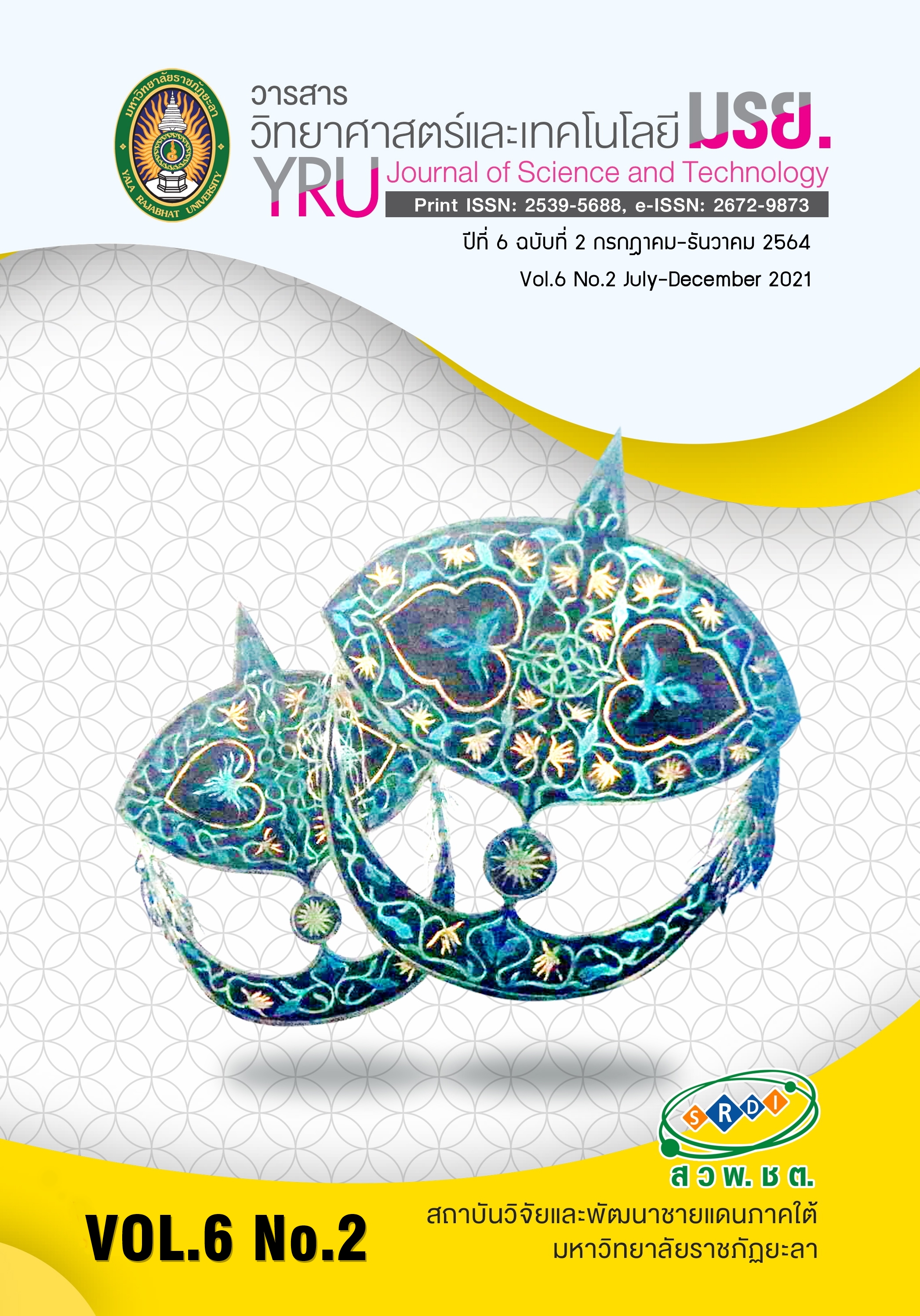ความเหมาะสมของน้ำประปาและน้ำบ่อตื้นสำหรับการบริโภคของชุมชนพื้นที่ตำบลสำนักขามในเขตเศรษฐกิจพิเศษสงขลาและพื้นที่ใกล้เคียง
Main Article Content
บทคัดย่อ
The Songkhla Special Economic Zone located in Sadao district is an important area because it attracts foreign investment-driven economic development at the Thailand-Malaysia border. Sumnakkham subdistrict, Sadao district, Songkhla province is an established area in the Sadao Industrial Estate.As a whole, industrial estate operations may cause pollution that affects the quality of water resources in the future. Therefore, it led to doubts about the water quality consumed by people in the area prior to the start of industrial estate operations. The purpose of this study was to assess the water supply and well water suitability for drinking in Sumnakkham in Songkhla Special Economic and Prik subdistricts (nearby area). Nine water samples were collected from four residences, four religious places, and one municipality waterworks authority. All samples were analyzed in comparison to the drinking water quality criteria of the Department of Health published in 2010. Results showed that most water samples passed all standard parameters except for three water samples from two mosques and one residence at Sumnakkham subdistrict where the amounts of coliform and fecal coliform bacteria and the concentrations of iron, fluoride and turbidity exceeded the standard. In addition, the water pH and iron concentration of well water in a residential area were found to be beyond an unsuitable range. To improve the quality of life of the residents, necessary improvements and continuous monitoring must be undertaken to ensure the quality of the drinking water in these communities.เขตเศรษฐกิจพิเศษสงขลาตั้งอยู่ในอำเภอสะเดา จังหวัดสงขลา เป็นพื้นที่ที่มีความสำคัญเนื่องจากเป็นพื้นที่ดึงดูดการพัฒนาเศรษฐกิจที่ขับเคลื่อนการลงทุนจากต่างประเทศชายแดนไทย-มาเลเซีย ตำบลสำนักขาม อำเภอสะเดา จังหวัดสงขลา เป็นพื้นที่จัดตั้งนิคมอุตสาหกรรมสะเดา โดยทั่วไปการดำเนินกิจการของนิคมอุตสาหกรรมอาจก่อให้เกิดมลพิษที่ส่งผลกระทบต่อคุณภาพของแหล่งน้ำในอนาคตได้ ดังนั้นจึงนำไปสู่ข้อสงสัยเกี่ยวกับคุณภาพน้ำที่ใช้บริโภคในพื้นที่ของประชาชน ก่อนที่จะมีการเริ่มดำเนินการของนิคมอุตสาหกรรม ซี่งการวิจัยนี้มีวัตถุประสงค์เพื่อประเมินความเหมาะสมของน้ำประปาและน้ำบ่อสำหรับการบริโภคของพื้นที่ตำบลสำนักขามในเขตเศรษฐกิจพิเศษสงขลาและพื้นที่ใกล้เคียงคือตำบลปริก อำเภอสะเดา จังหวัดสงขลา โดยเก็บตัวอย่างน้ำ 9 ตัวอย่าง จากบ้านพักอาศัยของประชาชน 4 หลัง สถานที่ทางศาสนา 4 แห่ง และการประปาเทศบาล 1 แห่ง ซึ่งตัวอย่างน้ำบริโภคทั้งหมดได้รับการวิเคราะห์โดยเปรียบเทียบกับเกณฑ์น้ำประปาดื่มได้ตามประกาศกรมอนามัย พ.ศ. 2553 ผลการศึกษาพบว่า ตัวอย่างน้ำส่วนใหญ่ผ่านเกณฑ์มาตรฐานทั้งหมด ยกเว้นตัวอย่างน้ำบริโภคจำนวน 3 ตัวอย่าง ที่เก็บจากก๊อกน้ำของมัสยิด 2 แห่ง และที่บ้านพักอาศัย 1 หลัง ในตำบลสำนักขาม ซึ่งตรวจพบ โคลิฟอร์มแบคทีเรีย ฟีคอลโคลิฟอร์มแบคทีเรียและยังพบความเข้มข้นของเหล็ก ฟลูออไรด์ และค่าความขุ่นเกินค่ามาตรฐาน นอกจากนี้ยังพบว่า ค่าพีเอชและความเข้มข้นของเหล็กในน้ำบ่อในพื้นที่พักอาศัยอยู่ในช่วงไม่เหมาะสม ดังนั้นเพื่อปรับปรุงคุณภาพชีวิตของผู้บริโภคจึงจำเป็นต้องดำเนินการปรับปรุงและติดตามคุณภาพน้ำอย่างต่อเนื่อง เพื่อให้เกิดความมั่นใจในคุณภาพของน้ำบริโภคในชุมชน
Article Details

อนุญาตภายใต้เงื่อนไข Creative Commons Attribution-NonCommercial-NoDerivatives 4.0 International License.
บทความ ข้อมูล เนื้อหา รูปภาพ ฯลฯ ที่ได้รับการเผยแพร่ในวารสารวิทยาศาสตร์และเทคโนโลยี มรย. นี้ ถือเป็นลิขสิทธิ์ของวารสารวิทยาศาสตร์และเทคโนโลยี มรย. หากบุคคลหรือหน่วยงานใดต้องการนำทั้งหมดหรือส่วนหนึ่งส่วนใดไปเผยแพร่ต่อหรือกระทำการใดๆ จะต้องได้รับอนุญาตเป็นลายลักษณ์อักษรจากวารสารวิทยาศาสตร์และเทคโนโลยี มรย. ก่อนเท่านั้น
เอกสารอ้างอิง
Anuar, A. R. & Harun, A. (2018). Malaysia-Thailand Cross Border Trade and Cross Border Special Economic Zone Potential: A Case Study of Rantau Panjang-Sungai Kolok Cross Border Town. Journal of International Studies, 14, 119-139.
APHA, AWWA & WEF (2017). Standard Methods for the Examination of Water and Wastewater (23rd). Washington DC.
Daud, M. K., Nafees, M., Ali, S. Rizwan, M. Bajwa, R. A., Shakoor, M. B., Arshad, M. U., Chatha, S. A. S., Deeba, F., Murad, W., Malook, I. & Zhu, S. J. (2017). Drinking Water Quality Status and Contamination in Pakistan. BioMed Research International,1-18. https://doi.org/10.1155/2017/7908183.
Department of Health, Thailand (2010). Drinking Water Quality Criteria [Online]. Retrieved May 12, 2020, from: https://www.mwa.co.th/ewt_dl_link.php?nid=33083. (in Thai)
Farhadkhani, M., Nikaeen, M., Adergani, BA., Hatamzadeh, M., Nabavi, BF. & Hassanzadeh, A. (2014). Assessment of drinking water quality from bottled water coolers. Iranian Journal of Public Health, 43(5), 674-681.
Fiebelkorn, AP., Person, B., Quick, RE., Vindigni, SM., Jhung, M., Bowen, A. & Riley, PL. (2012). Systematic Review of Behavior Change Research on Point-of-use Water Treatment Interventions in Countries Categorized as Low-to medium-development on the Human Development Index. Social Science and Medicine, 75(4), 622-633.
Rangsayatorn, N. (2006). Shallow groundwater quality assessment in Muang drstrict, Phayao. Naresuan University Journal, 14(2), 1-8.
Thailand Board of Investment (2018). A Guide to Investment in the Special Economic Development Zones (SEZ) [Online]. Retrieved May 15, 2020, from: https://www.nesdc.go.th/ewt_dl_link.php?nid=5197.
WHO (1986). Health Impact of Acidic Deposition. Science of the total environment 52, 157-187.
WHO (2003).Iron in Drinking-water Background Document for Development of WHO
Guidelines for Drinking-water Quality [Online]. Retrieved May 22, 2020, from: https://www.who.int/water_sanitation_health/dwq/chemicals/iron.pdf.
WHO (2004). Fluoride in Drinking-water Background Document for Development of WHO Guidelines for Drinking-water Quality [Online]. Retrieved June 12, 2020, from: https://www.who.int/water_sanitation_health/dwq/chemicals/fluoride.pdf.
WHO (2007). pH in Drinking-water Background Document for Development of WHO guidelines for Drinking-water Quality [Online]. Retrieved May 12,2020, from https://www.who.int/water_sanitation_health
/dwq/chemicals/ph_revised_2007_clean_version.pdf.


